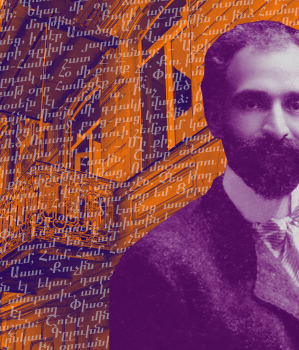Profile | Hovhannes Tumanian
Feb. 19, 1869 - March 23, 1923
ProfilePerhaps no author has captivated the hearts and minds of Armenians—young and old alike—as intensely as Hovhannes Tumanian. Often mislabeled as a children’s writer, Tumanian’s “simple” style represented literature that was of, and for, the masses—meant to be consumed by all—regardless of age, class, gender, or education level. No wonder, then, he is considered the national poet of Armenia.
The all-Armenian poet, activist, and maverick
Life at a Glance
Though born to a family of royal descent, Hovhannes Tumanian was a man of the people, in both quill and action. His childhood was surrounded by fables, conveyed eagerly by his storyteller mother and his priest father. At the age of 12, he wrote his first poem, and soon thereafter, attended the prestigious Nersisian school in Tiflis (present-day Tbilisi).
When his father passed away, he dropped out of school and took on a series of odd jobs to support his growing family (which soon included 10 children!). While contributing to many of the Armenian periodicals of the time, he also dove pen-first into literature, voraciously soaking up the works of many non-Armenian writers, and later “Armenianizing” them through his translations.
When conflict broke out around him, he engaged in public and social activism. From the Armenian-Tatar massacres to the Georgian-Armenian War, he remained committed to peace, choosing to see people at their most human level. This approach was reflected in his many poems and tales. Through kindness, empathy, and an acute sensibility, Tumanian tapped into the most fundamental elements, humanizing even the most flawed characters. Like Shakespeare, dozens of Tumanian’s expressions have entered the contemporary Armenian lexicon, becoming common sayings and adages today.

For a poet, each word is a world in itself.
-Hovhannes Tumanian
Character, spirit and style
Like the best painters, great writers evoke a “signature” style in their works. When one reads a Tumanian poem, fairy tale, quatrain, or novel, it is almost impossible to mistake it for anyone else. Some have described his work as realistic in form, others as tragedy in verse, and though his style evolved, his empathy and compassion for humans and nature never faltered. Tumanian’s prose was often written in the dialects of everyday countrymen and women, such as that of his childhood village in Lori. Few writers were as accessible to the masses, and even fewer saw representation of non-elite figures in literature. In this sense, Tumanian truly was the voice of the people.
Influences and contributions
A keen admirer of many European and American writers, such as Goethe, Lord Byron, Pushkin, and Longfellow, Tumanian sought inspiration through their works and translated many of them into Armenian. But perhaps his central inspiration were the common folk—villagers, peasants, and farmers—whom he elevated from peripheral characters to the hero(in)es of his fairy tales.
Achievements
- Feb. 19 (the day of his birth), is known as National Book Gifting Day in Armenia. The holiday honors the spirit of Tumanian, who himself was an avid book collector, with a purportedly impressive library collection!
- Tumanian founded the Vernatun (“Garret”) society, where prominent Armenian figures of the time would gather in his home to discuss literature, art, politics, and music. Some famous members included Nikol Aghbalian, the Minister of Education and Culture of the First Republic of Armenia; folklorist Ghazaros Aghayan; and Levon Shant, co-founder of the Hamazkayin Armenian Educational and Cultural Society.
- His fairy tales have been translated into many different languages, including English, Russian, Georgian, and most recently, Latvian, Lithuanian, and Hindi.
Interesting facts
- Tumanian was a lifelong peace advocate, serving as a negotiator during the Armenian-Tatar massacres of 1905-7, then again during the Armenian-Georgian War in 1919, when he was twice arrested for his efforts.
- When the Catholicos of All Armenians refused to shelter those escaping the genocide, Tumanian proclaimed that all refugees could seek relief in the Catholicos’ quarters under his order, as the “Poet of All Armenians.” That is how he earned the moniker, the “All-Armenian Poet.”
- Despite his notorious aversion to traveling, he went to Constantinople (now Istanbul) to assist Armenian Genocide refugees, where he fell ill and never recovered, passing away in a Moscow hospital at the age of 54.
- The TUMO Center for Creative Technologies is named after Tumanian.
Awards and recognition
- Today, three house-museums honor Tumanian in Armenia and Georgia. A statue of him stands in Yerevan’s Freedom Square, another inside his house-museum in Tiflis, and a third will soon be erected in Rome.
- Tumanian’s 150th birthday was included in the UNESCO Calendar of anniversaries of eminent personalities and important events of 2018-2019.
- On the 150th anniversary of his birth, the Central Bank of Armenia issued gold commemorative coins dedicated to the poet.
Today, Tumanian’s tongue has reached a crystalline simplicity that approaches Pushkin, and which should be considered one of his highest virtues.
- Vahan Terian <br> (1885-1920)

Attention!